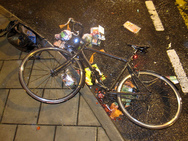What is “contributory negligence,” and why is it such a big danger for cyclists and pedestrians?

Photo by Moff on Flickr.
Say you are riding along on your bicycle. Your tail light battery dies one evening, and then a texting driver crashes into you. Can you recover your medical costs from the driver?
Or, say you are on foot and need to cross a street where the nearest crosswalks are far away. But then a drunk driver speeds by and hits you.
Or, you’re biking and get doored. A police officer, confused about the law, incorrectly tickets you for riding too close to parked cars.
Unfortunately, you may not be able to collect any compensation for your smashed-up bike, your broken leg, or the days of work you missed. That’s because of a legal doctrine called contributory negligence.
Only four states (Maryland and Virginia among them) and the District of Columbia retain this outdated legal doctrine. Fortunately, a bill in the DC Council aims to correct this in the District, at least for bicyclists. There’s a hearing this Monday, September 29.
How does contributory negligence work?
Generally, after a crash between a motorist and a bicyclist or pedestrian, there is an injured bicyclist or pedestrian and an uninjured motorist. The cyclist or pedestrian often will seek compensation for injuries from the motorist and the motorist’s insurer.
If everyone involved agrees that the cyclist or pedestrian behaved perfectly and the driver was completely at fault, the cyclist will be able to recover compensation. Unfortunately, such agreement is rare. If the cyclist or pedestrian was at fault to any degree, he or she will not be able to recover compensation for injuries suffered in the crash.
This is true even if the crash was only 1% the cyclist or pedestrian’s fault, 99% the driver’s fault, and all of the injuries were suffered by the cyclist or pedestrian. For this reason, it is often called the “one percent” rule.
The cyclist or pedestrian is likely out of luck if the insurer or a police officer believes the cyclist or pedestrian was at fault through misunderstanding or misapplying the law. In rare cases, the injured person can find video proof that he was not breaking a law, but if that’s not possible, insurers can and generally do treat a ticket from a police officer as evidence enough that the cyclist or pedestrian was at least slightly at fault.
What’s being done about it?
DC Councilmember David Grosso recently introduced the “Bicycle and Motor Vehicle Collision Recovery Amendment Act of 2014″ with Councilmembers Mary Cheh and Tommy Wells also co-introducing the bill. It would update DC law to the fairer, more modern Comparative Negligence standard for crashes between drivers and bicyclists. This means if you’re in this situation on a bicycle, your compensation would be reduced to the extent that you were responsible for the crash, but not eliminated entirely.
For example: A motorist exiting her vehicle at night opens her driver’s side door into the bike lane, striking a cyclist who had no light at night. The motorist’s door is not damaged and the motorist is unharmed, but the cyclist suffers a broken arm from the fall and ends up with $1,000 in medical bills.
Under the present contributory negligence standard, the cyclist’s failure to have a light would prevent her from any recovering any damages, even though the motorist broke the law by opening her door into traffic.
Under the new bill, the decision-maker (whether judge, jury, or insurance adjuster) would have to determine the proportionate fault of the parties and determine the damages accordingly. So, if the decision-maker finds that the driver opening her door into the bike lane without looking was 75% responsible for the injury and the cyclist’s failure to have a light was 25% responsible for the injury, the injured cyclists could recover 75% of her damages, or $750 in this scenario.
Can this bill cover pedestrians as well?
At the moment, the bill as introduced only applies to crashes between drivers and bicyclists. However, pedestrian advocacy group All Walks DC has worked with Grosso’s staff to write an amendment to the bill to cover pedestrians, which he will introduce in committee.
Have other states changed their negligence standard?
Contributory negligence came to the US from English common law. But over time, many courts or states changed the standard to the fairer comparative one through caselaw or legislation.
Today, 45 states and the federal court system have adopted comparative negligence as a basis for apportioning fault between parties in tort suits. Currently, just four states (including both Maryland and Virginia) and the District of Columbia continue to use contributory negligence as a bar to recovery and access to courts.
Is there any precedent in current law for an exemption such as this?
Yes. Current District of Columbia law extends the additional legal protection of comparative negligence to railroad workers.
Who benefits or loses out if this bill becomes law?
Cyclists and motorists alike benefit from having damages equitably distributed after from a collision. (Pedestrians would as well if the bill expanded to cover them).
Insurance companies, on the other hand, presently do not have to pay for the negligence of the drivers they insure if they hit a cyclist or pedestrian who has been negligent to even the smallest degree. Under a different standard, they would pay.
Contributory negligence is not an economically efficient or fair method for determining compensation after crashes. It does not compensate injured parties who were not primarily responsible for their injuries. It allows the insurers of the primarily negligent party to avoid compensating the injured.
This happened to me! How can I help?
If you or other bicyclists or pedestrians you know have been hit and had an insurance claim reduced or denied, please consider testifying at the hearing Monday, September 29 at 12:30 pm. To sign up to testify, email Nicole Goines at ngoines@dccouncil.us or call 202-724-7808.
